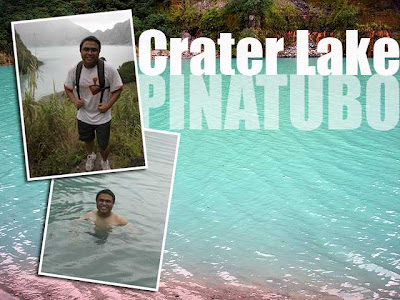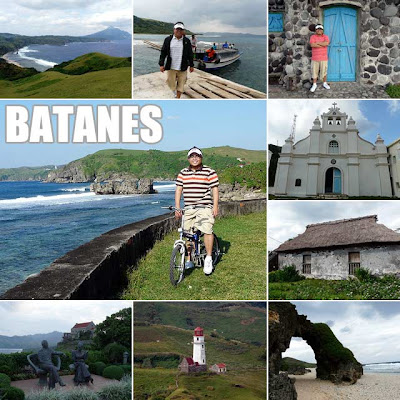
I could not believe it! I was standing on the
rooftop of Luzon, 2,922 meters above sea level! Just months ago, I was wondering if I could reach the summit of
Mt. Pulag given my physical limitations. But a spur of the moment decision to go to Pulag changed all that. We planned our Pulag trip barely a week before our actual climb. In fact, we bought all our gear at
R.O.X. the night we left.
It was a long and tiring drive to Baguio. We got there at 7 a.m. where we had breakfast. We tried to leave Baguio as early as possible so that we could start our trek early. But since we were all first-timers, we didn't know which direction to take, went the wrong way and found ourselves in Halsema Highway. Our GPS had taken us to the shortest route off Halsema Highway which was a really rough road, so we had to turn back, return to Baguio City and find the road via Ambuklao.

There are five major roads leading to Baguio namely
Kennon, Marcos,
Naguilan, Halsema (via La Trinidad), and Ambuklao. It was my first time to use the Ambuklao Road. And thus with this trip, I've finally passed by all five. Not only that, I also used all five within the week - Kennon Road on Tuesday,
Naguilan on Wednesday, Marcos, Halsema and Ambuklao on Saturday and Kennon again yesterday!
The Ambuklao Road is as picturesque as Kennon, especially when you drove past the
Ambuklao Dam and Lake. The trip from Baguio to Ambangeg in Bokod, Benguet is roughly three hours. Most of the roads are well-paved except for bumpy parts at Ambuklao Dam and from the Bokod Poblacion to Ambangeg.
First thing you have to do before climbing Mount Pulag is to register at the
Visitors Center (DENR Office) in
Ambangeg. We paid PHP175 each. Then from there, you need to go up 10 kilometers to the
Ranger Station where people start the trek up to the summit.

Only a 4x4 can do that trip so if there are just a few of you, you could hire a
habal-habal to get you there (if you hired a jeep from Baguio, that could bring you up as well). You can also opt to hike up, but that is even harder than the trek from the Ranger Station to the summit of Mt. Pulag itself! Since there were not enough motorcycles, my companions Lemuel, Mike and Caloy decided to trek, and they had a lot of "fun" going up! So it's best to find a ride up. Our plan was to pitch a tent at
Camp 2 and stay there for the night. But since it was getting dark when the three arrived at the Ranger Station, we decided to sleep there. And boy was it a good decision!

For some weird reason, the temperature dropped suddenly while I was waiting at the Ranger Station. It was quite warm when I took a nap late in the afternoon. And I suddenly woke up shivering from the cold. The locals told us that winds brought in the cold temperature. Imagine if we did stay in a tent at Camp 2, we might have suffered from hypothermia even before the climb! Even inside the Ranger Station we were freezing!
We had some canned goods and bread for dinner before an early lights out at 8 p.m. Since we were behind schedule, we had to leave the Ranger Station at 12:30 a.m. (instead of leaving Camp 2 at 4 a.m.) to reach the summit by sunrise.

It was still cold and we also had to trek all the way in the dark which made it even more difficult. We reached Camp 1 at 1:45 a.m. and Camp 2 at 3:30 a.m. It was an ordeal for me but thanks to the cold temperature, it wasn't as hard as trekking under the sun. I finally made it up to the summit at 5:45 a.m. just in time for the sunrise!
The view at the top was surreal. You could see the entire Cordilleras all around you. From there I could also see Magat Dam, Ambuklao Dam, and the mountains of the Sierra Madre as well. But the winds brought in a shivering cold that hit us right down to the bone. And we had to sit behind small bamboo bushes to shield us from the cold winds.

After about 30 minutes enjoying nature's couch, our guide signaled to us that it was time to go down. He told me if we stayed any longer, we might suffer from hypothermia. Now that the sun was out, we could see the trail. And boy did it shock us since we also saw the deep ravine right beside the trail. You really had to be careful, especially if trekking in the dark.

Going down was easier but it was only then that we realized how far we had trekked. Backtracking, it made me wonder how I managed to climb up all the way to the top! As soon as we entered Camp 2, we were greeted by the forests of Mt. Pulag. The name Pulag in the Kalanguya languange means bald mountain since trees could not grow near the summit due to frost. Anyway, the forests at Camp 2 were also a wonderful sight!
Walking down, it was enriching looking at the different species of trees, plants and flowers. God really knows how to color the world. I finally reached the Ranger Station at 10:30 a.m. after 10 hours of trekking!

After lunch, we left the Ranger Station for Ambangeg. Going down from the Ranger Station to Ambangeg is another ordeal if you take the
habal-habal since you'll be holding on for your dear life! They had to bring us down in two trips since there were just two of them. The ride itself is about an hour. So we took a nap at DENR while waiting for the rest. We had dinner at 50s Diner in Baguio City before proceeding back to Manila.
For the detailed Ambangeg itinerary, check out
Pinoy Mountaineer.














































